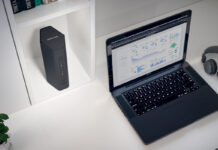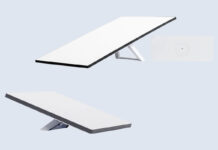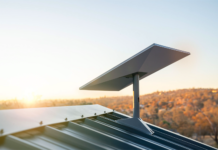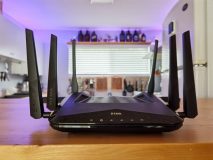
With smart lights, voice assistants, and smart TVs, I have a lot of devices connected to my home Wi-Fi network. D-Link’s new AX4800 Mesh Wi-Fi 6 router (DIR-X4860) is geared towards smart homeowners like myself. I just don’t want a Wi-Fi 6 router, I need the “Tesla” of Wi-Fi 6 routers. If you’re like me and take your wireless network seriously, this router review is for you.
Design
The DIR-X4860 looks like a cross between a spaceship and a spider. It features a total of six antennas. Four are non-removable, and two need to be screwed in. The two removable antennas are coded gold and silver. This helps to identify the side it goes on, as the connectors on the router are also color-coded gold and silver.
I’ve reviewed many routers in the past but I’ve never seen one that has both removable and non-removable antennas. I’m still trying to figure out why they did that. I suspect it just makes it easier to ship. It was probably too hard to get six non-removable antennas into a box.
The front has six LED light indicators for power, Internet, 2.4GHZ/5GHz bands, and USB 2.0/3.0. The back features a yellow Gigabit WAN port, four Gigabit LAN ports, USB 2.0 port, and a USB 3.0 port.
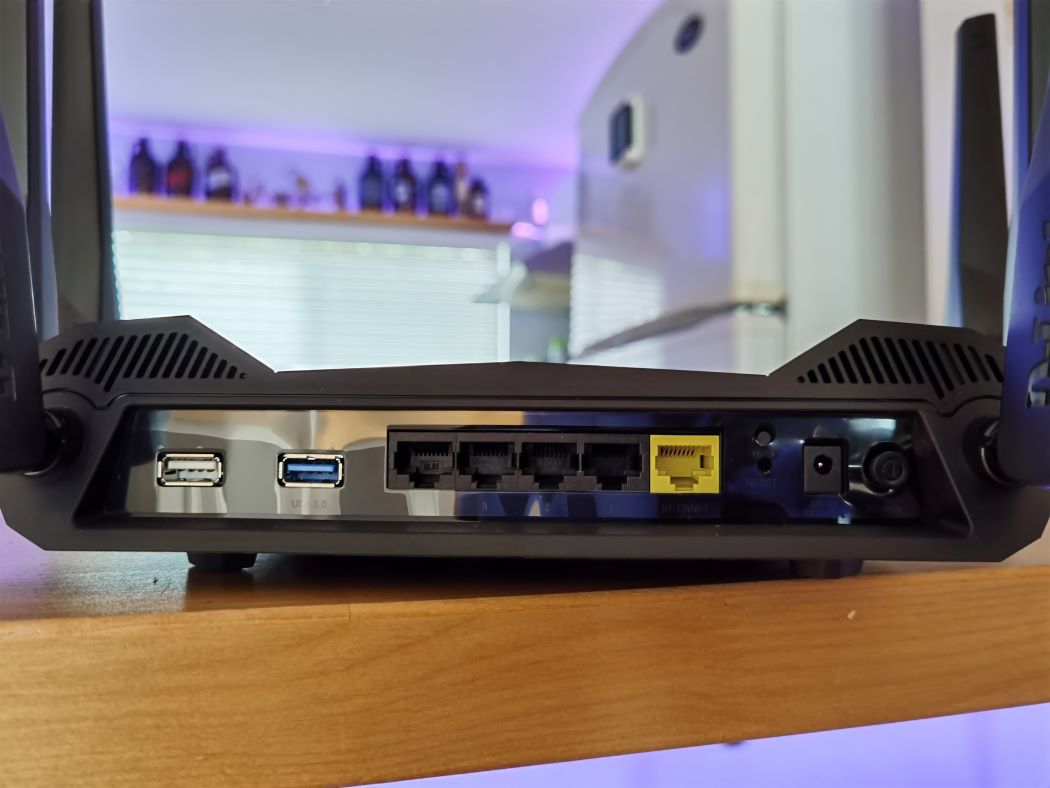
Notable features
The four LAN ports also feature Link Aggregation. This is a feature I’ve been using a lot in my home network. Link aggregation bundles Ethernet links together so they act as a single link. By enabling link aggregation, I increase the performance with my network-attached storage (NAS) and the router. This is a great way to take advantage of extra LAN ports when you have a NAS.
Another feature I was interested in was BSS Coloring. With Wi-Fi 6, the router color-codes shared frequencies when data is passed between the device and the network. This increases the signal range by reducing wireless interference in “noisy” Wi-Fi environments. This is a must-have feature in smart homes like mine, with dozens of devices connected to the network.
Setup
Setting up the AX4800 Wi-Fi 6 was a breeze. On the bottom of the router is a QR code and default network name (SSID) and password. That same information is also available on the Quick Install Card. Using the D-Link Wi-Fi app, I scanned the QR code and proceeded through the steps.
 The app shows the antenna setup with the gold and silver connectors. This ensures the user places them on the right side. It then guides through the steps on connecting the modem to the router.
The app shows the antenna setup with the gold and silver connectors. This ensures the user places them on the right side. It then guides through the steps on connecting the modem to the router.
It’s important to follow these steps in order. Many of the problems people have with router installation happen here. They do not power cycle their modem before turning the router on. I was glad to see that the D-Link Wi-Fi app guides users through these steps to ensure proper installation.
After turning the router on, the Wi-Fi LED lights were solid white, indicating it was ready for configuration.
The installation was completed in 5 minutes. I created a new network name (SSID) and password and took the speed test provided in the D-Link Wi-Fi app. The results were deemed excellent and the setup was complete.
Performance

As a dual-band router, the AX4800 has up to 600 Mbps on the 2.4GHz band and 4200 Mbps on 5GHz. Users can have up to 6 simultaneous streams, with two streams on 2.4GHz and four on 5GHz.
I recently reviewed the D-link AX1500 Mesh Wi-Fi 6 router, an entry-level version of the AX4800. The AX4800 was installed in the same location in my living room. Now I could compare the performance results between the two.
I used an app on my phone that measures the Wi-Fi signal strength. As expected, right beside the router, I had a 99% signal strength on the 5GHz network. In my home studio, the signal strength dropped down to 81%. With the four-antenna AX1500, the signal strength was 55% in the same location. That tells me that the two extra powered antennas really do make a difference.

The ultimate test was outdoors, on my backyard “smart” deck. I have an assortment of smart home products installed here, ranging from Google Chromecast connected to a TV, to wireless security lights. My ultimate dream is to have a strong 5GHz signal in the backyard so nothing loses connection. The D-Link Wireless Outdoor Wi-Fi Spotlight camera installed on my back deck loses connection. Thus, I need a stronger and more consistent Wi-Fi signal outdoors.
When I had the AX1500 installed, I could not get Wi-Fi signal on the deck. With the AX4800, I was unable to get a connection on the 5GHz band. This is an inherent aspect of the 5GHz frequency. Although it can provide faster speeds, the 2.4GHz band has a better Wi-Fi range.
In the D-Link Wi-Fi app, I disabled SmartConnect. The router now created separate 2.4GHz and 5GHz networks. I logged into the 2.4GHz band and was able to get a connection. The signal strength on the backyard deck was 46%. Most routers I’ve reviewed cannot provide a signal to that area.
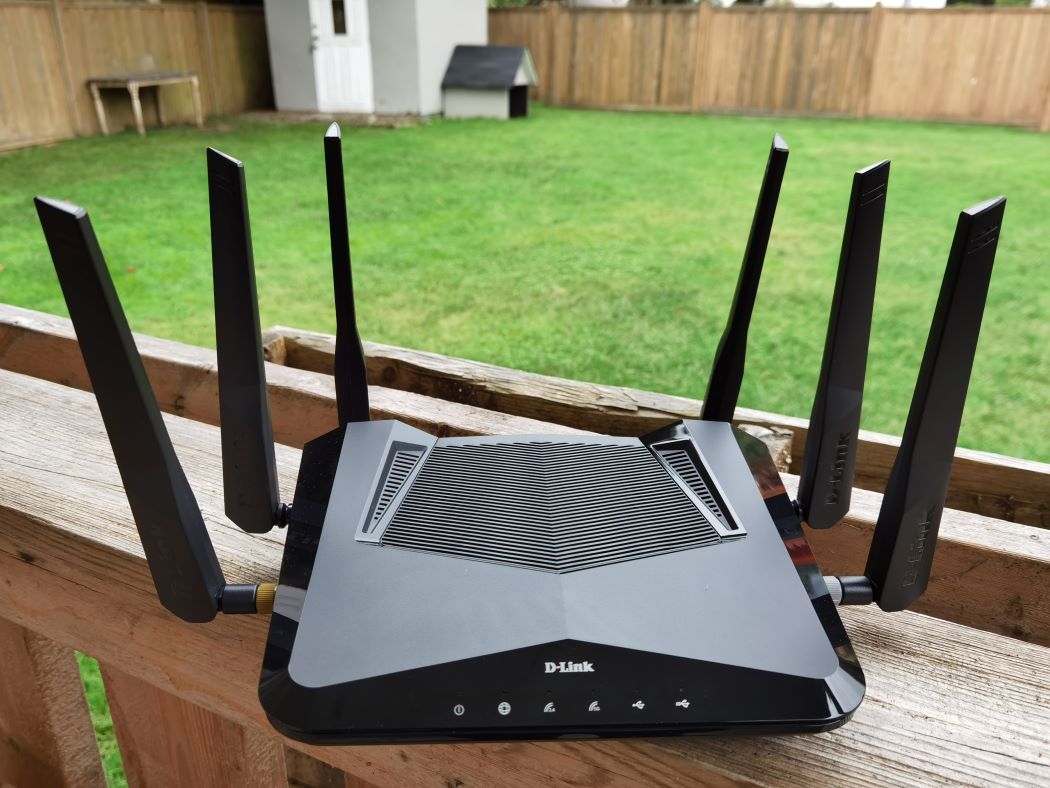
Final Thoughts
With the wireless AC standard of 2014 (Wi-Fi 5), we had to choose between a router or a mesh home Wi-Fi system. With Wi-Fi 6, those two networking worlds are merging into one. The AX4800 is a high-end, mesh-enabled WiFi 6 router. It provides phenomenal speed and signal range. It allows me to extend the Wi-Fi range with extenders, all under the same networking name.
I wish I had another compatible mesh-enabled extender to connect to the AX4800. The dream is to extend the 5GHz band to my backyard “smart” deck. I currently have a mesh system, but it’s not Wi-Fi 6. With the right placement, I really wonder how big of a mesh network you could create with D-Link’s Wi-Fi 6 products.
Having a smart home with dozens of devices, I need to soon upgrade my hardware to Wi-Fi 6. After all the tests I did with the D-Link AX4800 Mesh Wi-Fi 6 router, it is something I would seriously consider. If some additional mesh-enabled extenders could push the 5GHz band to my backyard deck, it would be the perfect system for my smart home setup.

